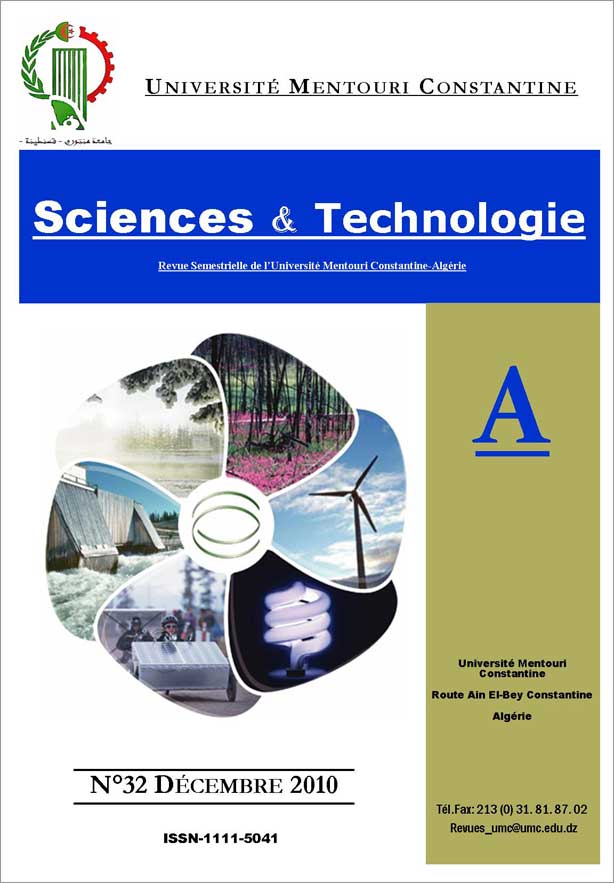ETUDE PAR DFT+U DE L’INTERACTION Ni-CeO2
Keywords:
Ni, CeO2, DFT U, GGA, LDA, Surfaces, insertion, adsorptionAbstract
L’étude de l’interaction Ni-CeO2 a été entreprise en utilisant une méthode ab initio basée sur la DFT+U. Dans une première étape, les valeurs du paramètre d’Hubbard, Ueff, ont été déterminées après ajustement du paramètre de maille et de l’énergie de gap du volume de l’oxyde de cérium. Elles sont respectivement de 3 et 5 eV pour les approximations GGA et LDA. Nous avons ensuite étudié d’une part la possibilité d’insérer le nickel atomique dans le volume de CeO2. D’autre part, nous avons testé les effets de l’insertion et l’adsorption de Ni dans les surfaces les plus stables (111) et (110) de CeO2. Les résultats des calculs DFT+U sont en bon accord avec ceux que nous avons précédemment trouvé en utilisant un calcul DFT concernant les sites favorables de l’atome de nickel et le nombre de liaisons. Toutefois, l’approximation LDA+5 eV, a permis d’obtenir des énergies plus favorables ainsi que des distances comparables à celles observées expérimentalement à l’interface métal/oxyde dans les catalyseurs Ni/CeO2 synthétisés sous irradiation. Une expansion du volume est observée lors de l’insertion du nickel dans le volume de l’oxyde de cérium. Concernant l’adsorption sur les surfaces, la meilleure énergie est trouvée dans le cas où l’atome de nickel est situé en position bridge entre deux atomes d’oxygène sur la surface (110). Finalement, les calculs montrent que le nickel s’insère plus facilement dans la surface (110) avec une meilleure énergie d’insertion, obtenue par l’approximation LDA+5 eV, de 4,071 eV.Downloads
References
Terribile D., Trovarelli A., de Leitenburg C., Primavera A. and Dolcetti G., Catalytic combustion of hydrocarbons with Mn and Cu-doped ceria–zirconia solid solutions. Catalysis Today, Volume 47, Issues 1-4, 1. (1999). 133-140.
Ozawa M., Loong C.-K, “In situ X-ray and neutron powder diffraction studies of redox behavior in CeO2- containing oxide catalysts”. Catalysis Today. 50. (1999). pp. 329 - 342.
Ozawa M., “Role of cerium–zirconium mixed oxides as catalysts for car pollution” A short review Journal of Alloys and Compounds. 275-277. (1998). 886 - 890.
Palmqvist A. E., Wirde M., Gelius U., Muhammed M., “Surfaces of doped nanophase cerium oxide catalysts”. Nanostructured Materials. (1999). 995-1007.
Chen H., Sayari A., Adnot A., Larachi F., “Composition-activity effects of Mn-Ce-O composites on phenol catalytic oxidation”. Applied Catalysis B:
Environmental. 32. (2001). 195 - 204.
Pfau A., Schierbaum K. D., “The electronic structure of stoichiometric and reduced CeO2 surfaces: an XPS, UPS and HREELS study”. Surface Science. 321. (1994). 71-80.
Namai Y., Fukui K.-I., Iwasawa Y., “Atom resolved noncontact atomic force microscopic observations of CeO2 (111) surfaces with different oxidation states: surface structure and behavior of surface oxygen atoms”. J. Phys. Chem. B, 107. (2003). 11666-11673.
Fabris S., De Gironcoli S., Baroni S., “Reply to Comment on ‘Taming multiple valency with density functionals: A case study of defective ceria' ”. Phys. Rev B. 72. (2005). 237102-237103.
Ganduglia-Pirovano. M.V, Hofmann. A, Sauer. J, “Oxygen vacancies in transition metal and rare earth oxides : Current state of understanding and remaining challenges”. Surface Science. 62, 6. (2007). 219-270.
Loschen C., Carrasco J., Neyman K. M., Illas F, “Firstprinciples
LDA+U and GGA+U study of cerium oxides: Dependence on the effective U parameter. Phys. Rev. B. 75. (2007) 0355115-0355122.
Zhou J., Mullins D. R., “Adsorption and Reaction of Formaldehyde on Thin-film Cerium Oxide” Surface Science. 600. (2006). 1540-1546.
Skorodumova N. V., Ahuja R., Simak S. I., Abrikosov I. A., Johansson B., Lundqvist B., “Electronic, bonding, and optical properties of CeO2 and Ce2O3 from first principles”. Phys. Rev. B. 64 (2001). 115108_1- 115108_9.
Namai Y., Fukui K-I., Iwasawa Y., “Atom-resolved noncontact atomic force microscopic and scanning tunneling microscopic observations of the structure and dynamic behavior of CeO2(111) surfaces” , Catal. Today
(2003). 79-91.
Gates B. C., Catalytic Chemistry; Wiley: New York, (1992).
Henry C. R., “Surface studies of supported model catalysts”. Surf. Sci. Rep. 31. (1998). 231-325.
Chafi Z., Keghouche N., Minot C., “DFT study of Ni–CeO2 interaction: Adsorption and insertion”. Surface Science. 601. (2007). 2323-2329.
Chafi Z., Keghouche N., Minot C., “Density function theoretical study of interaction of hydrogen with ceria”. Physics Procedia. 2. (2009). 673-676.
Chafi Z., Keghouche N. et Minot C. “Etude par DFT de l’interaction nickel-oxyde de cérium”. Revue Algérienne de Physique. 03. (2009). 88-92.
Dudarev S. L., Botton G. A., Savrasov S.Y., Humphreys C. J., and Sutton. A. P., Phys. Rev. B. 57. (1998). 1505-1509.
Kresse. G, Hafner. J., “Norm-conserving and ultrasoft pseudopotentials for first-row and transition elements”. Condens. Matter. 6. (1994). 8245-8257.
Kresse. G, Hafner. J., “Ab initio molecular dynamics for liquid metals”. Phys. Rev. B, 47. (1993). RC 558-561.
Kresse G., Hafner J., “Ab initio molecular dynamics for open-shell transition metals Phys. Rev. B. 48. (1993). 13115-13118.
Kresse. G, Furthmüller. Efficient iterative schemes for ab initio total-energy calculations using a plane-wave basis set. J. Phys. Rev. B. 54 (1996)11169-11186.
Kresse. G, Furthmüller. Efficiency of ab-initio total energy calculations for metals and semiconductors usoing a plane-wave basis set. J. Computat. Mat. Sci. 6. (1996).15-50.
Perdew J. P., Chevary J. A., Vosko S. H., K. Jackson A., Pederson M. R., Singh D.J., et Fioljais. C., “Atoms, molecules, solids ans surfaces: Applications of generalized gradient approximation for exchange and correlation. Phys. Rev. B. 46. (1992). 6671.
Perdew J. P., Wang Y., “Accurate and simple analytic representation of the electron-gas correlation energy. Phys. Rev. B. 45. (1992). 13244.
Chettibi. S, Wojcieszak. R, Boudjennad. E. H, Belloni. J, Bettehar. M. M, Keghouche. N., Ni–Ce intermetallic phases in CeO2-supported nickel catalysts synthesized by γ- radiolysis Catal. Today. 113. (2006). 157-165.







